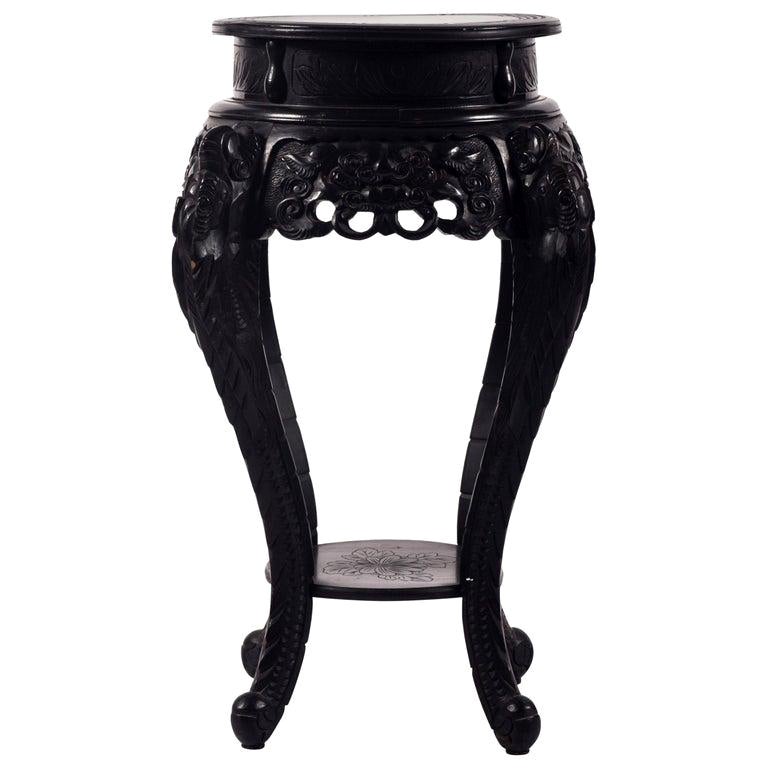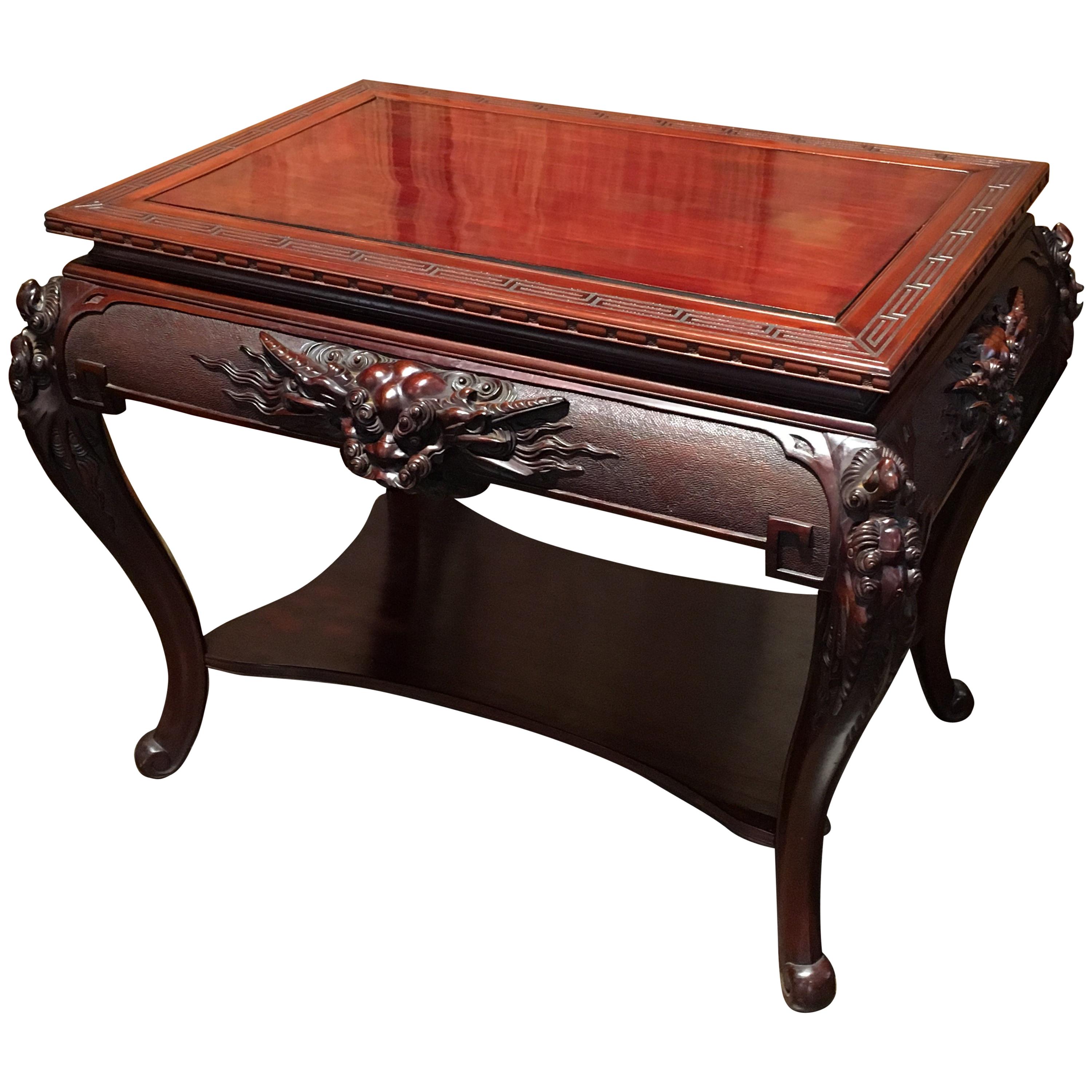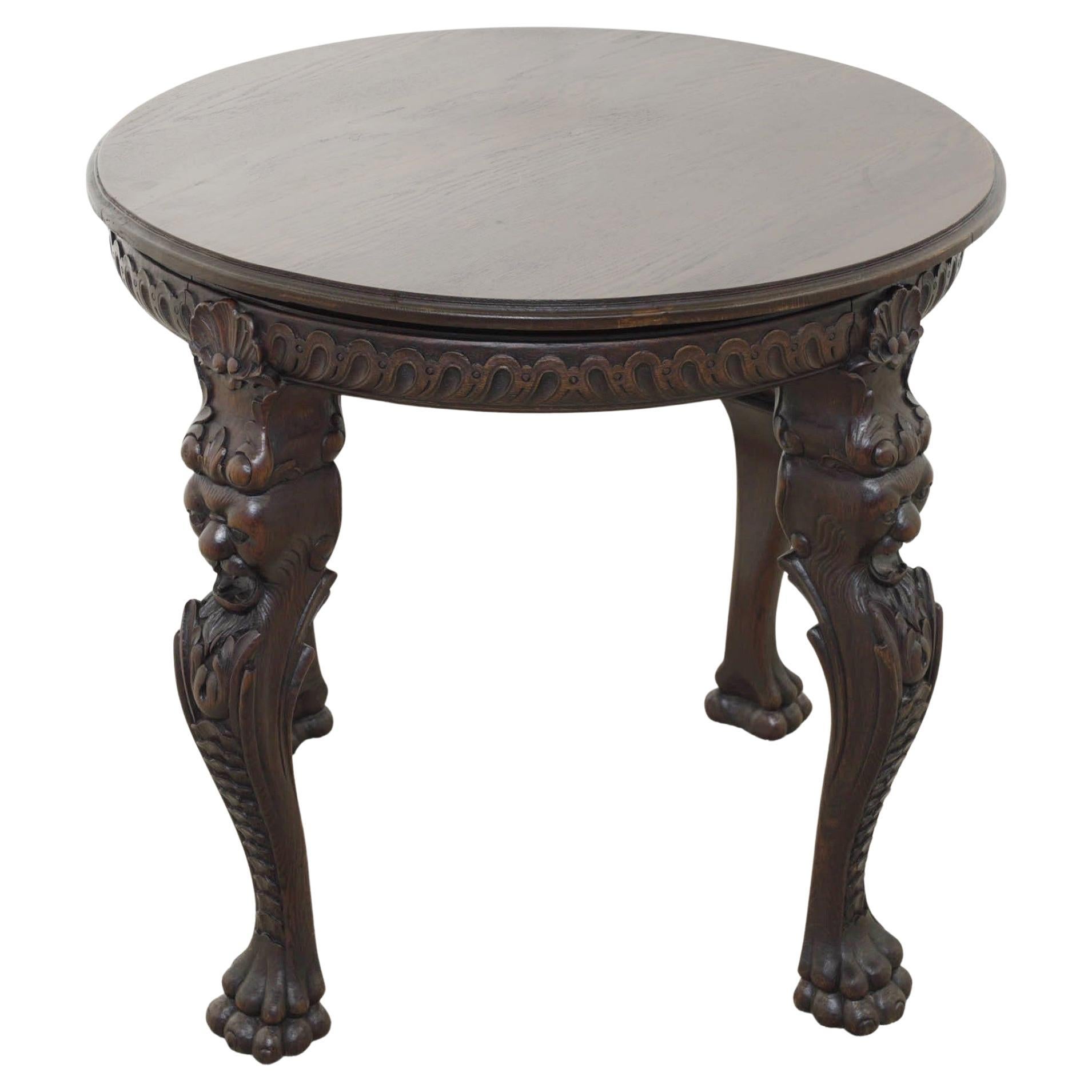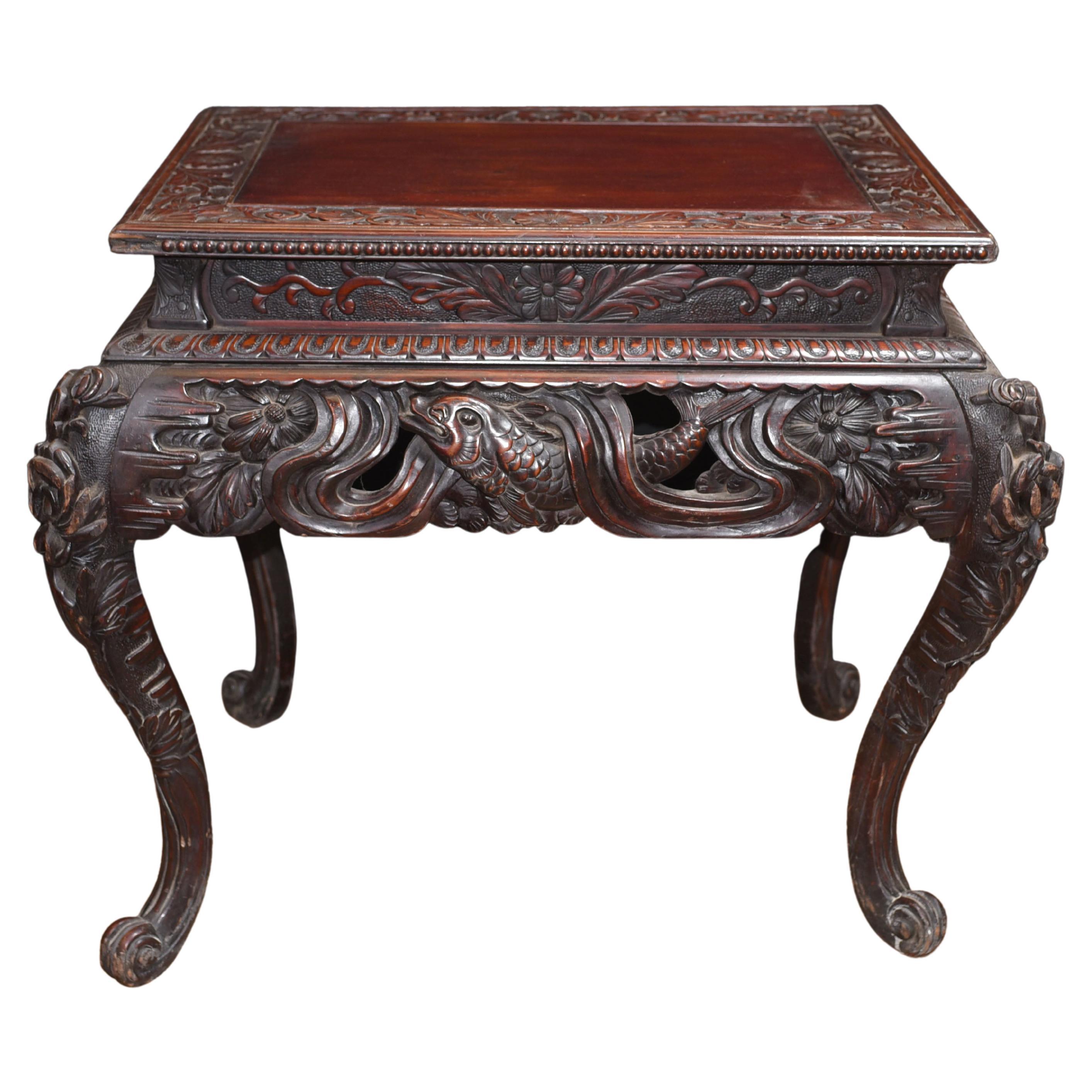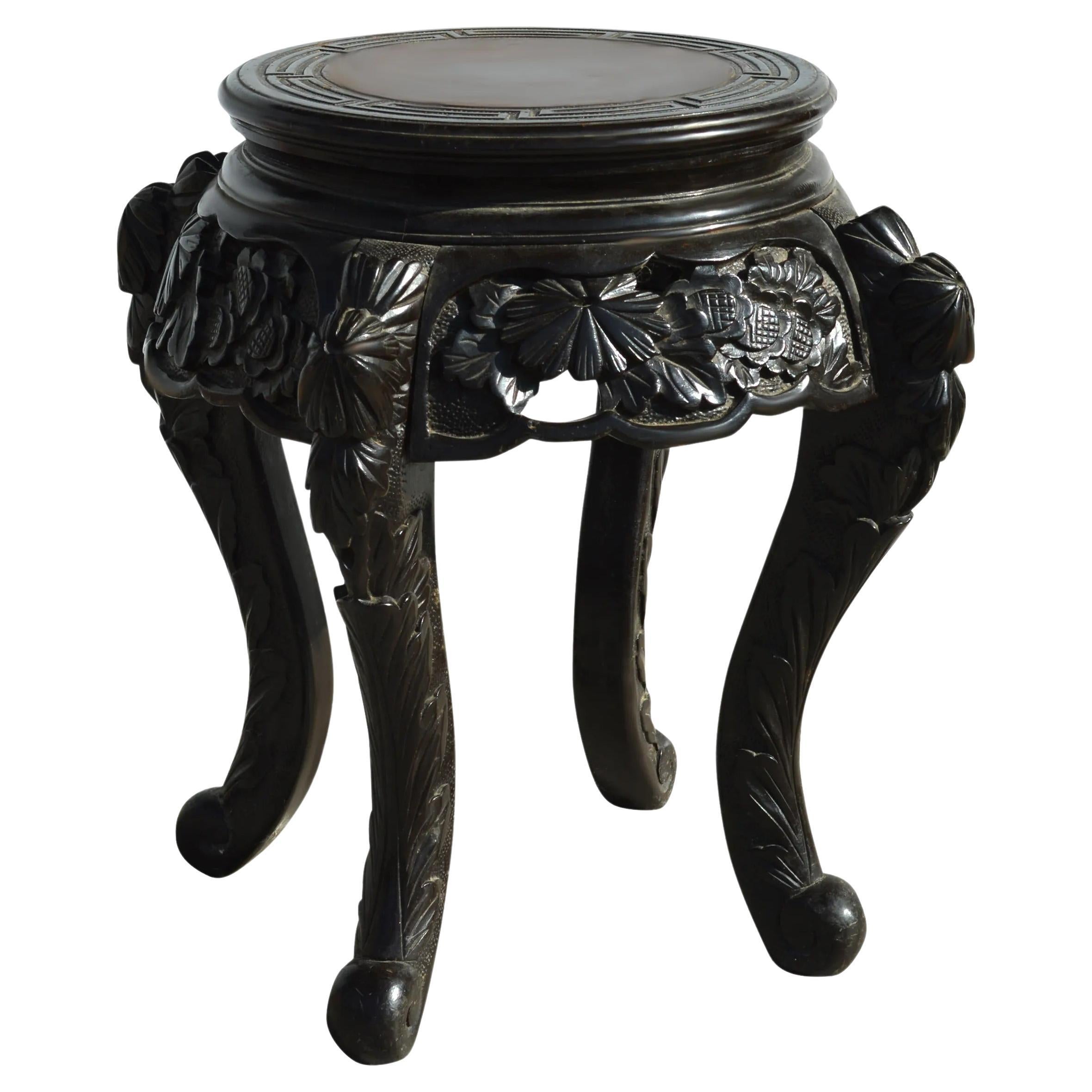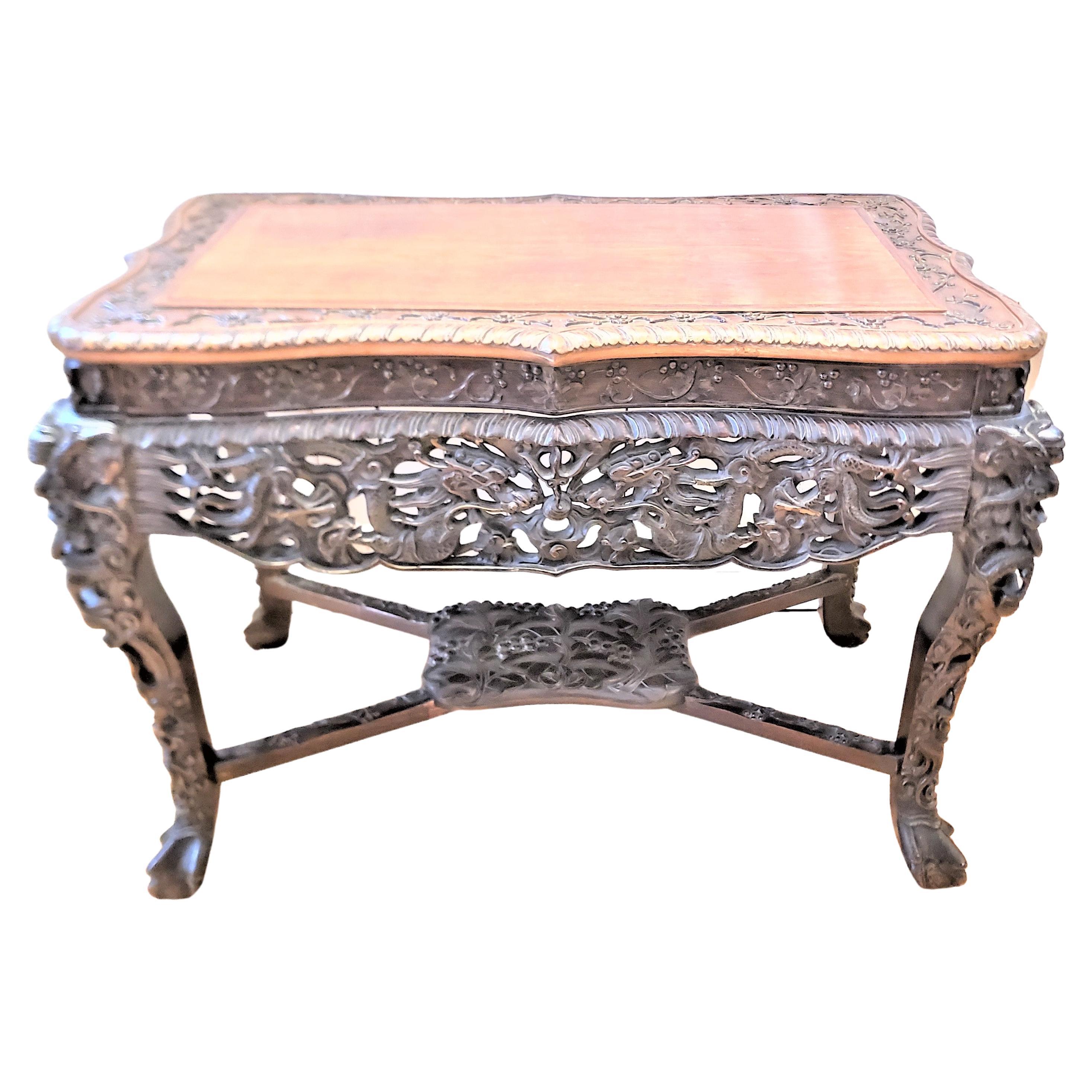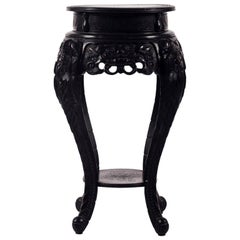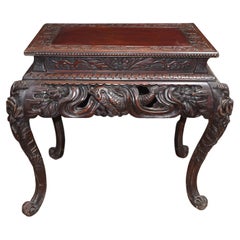Items Similar to Antique Japanese Meiji Period Elaborate Flying Dragon Table
Want more images or videos?
Request additional images or videos from the seller
1 of 11
Antique Japanese Meiji Period Elaborate Flying Dragon Table
$3,300
£2,474.33
€2,868.62
CA$4,605.32
A$5,143.73
CHF 2,672.84
MX$62,640.23
NOK 33,950.99
SEK 31,991.62
DKK 21,403.38
Shipping
Retrieving quote...The 1stDibs Promise:
Authenticity Guarantee,
Money-Back Guarantee,
24-Hour Cancellation
About the Item
A magnificent antique Japanese powerfully carved center table with dragons from the Meiji period.
The growth of urban centers and spread of wealth during the Meiji Restoration period in Japan ushered in an era that reveled in the aesthetic qualities of objects and actions in everyday life. This ornately carved figural table from the late 19th century / early 20th century demonstrates the level of pleasure and luxury pursued by the wealthy.
The mythical dragon-inspired shape echoes throughout the elaborately hand carved ebonized hardwood; with an unadorned inset polished circular rich rosewood colored top with attractive wood graining; scalloped border and edge with ornate running ornamentation between; rises over the profusely carved and stylized skirt with carvings of whimsical dragon mask and spread wings in high relief and open scrollwork; raised on four spoon carved scale like curved dragon tail cabriole legs, resting on scrolled feet
Circa 1880-1910
Dimensions (approx):
30.5" height x 38" diameter
Great condition. Antique condition. Minor scratches and losses with scattered minor flaking to finish throughout. New construction supports to underside. Very solid/sturdy. Structurally sound. Presents well.
Delivered cleaned, waxed and ready for many years of use.
- Dimensions:Height: 30.5 in (77.47 cm)Width: 38 in (96.52 cm)Depth: 38 in (96.52 cm)
- Style:Meiji (Of the Period)
- Materials and Techniques:Rosewood,Ebonized
- Place of Origin:Asia
- Period:Early 20th Century
- Date of Manufacture:Late 19th/Early 20th Century
- Condition:Replacements made: New construction supports to underside. Wear consistent with age and use. Minor losses. Minor fading. Great condition. Antique condition. Minor scratches and losses with scattered minor flaking to finish throughout. New construction supports to underside. Very solid/sturdy. Structurally sound. Presents well.
- Seller Location:Forney, TX
- Reference Number:1stDibs: LU5977226967232
About the Seller
4.8
Platinum Seller
Premium sellers with a 4.7+ rating and 24-hour response times
Established in 2013
1stDibs seller since 2021
290 sales on 1stDibs
Typical response time: 1 hour
- ShippingRetrieving quote...Shipping from: Forney, TX
- Return Policy
Authenticity Guarantee
In the unlikely event there’s an issue with an item’s authenticity, contact us within 1 year for a full refund. DetailsMoney-Back Guarantee
If your item is not as described, is damaged in transit, or does not arrive, contact us within 7 days for a full refund. Details24-Hour Cancellation
You have a 24-hour grace period in which to reconsider your purchase, with no questions asked.Vetted Professional Sellers
Our world-class sellers must adhere to strict standards for service and quality, maintaining the integrity of our listings.Price-Match Guarantee
If you find that a seller listed the same item for a lower price elsewhere, we’ll match it.Trusted Global Delivery
Our best-in-class carrier network provides specialized shipping options worldwide, including custom delivery.More From This Seller
View AllAntique Japanese Export Meiji Era Highly Carved Hongmu Library Table Desk
Located in Forney, TX
A superb Meiji Era (1867-1912) intricately hand carved Japanese hardwood writing table with beautifully aged patina, warm wood coloring, richly figured grain patterns, and interestin...
Category
Early 20th Century Japanese Meiji Furniture
Materials
Wood, Rosewood, Lacquer
19th Century Victorian Highly Carved Parlor Table
Located in Forney, TX
A very fine 19th century Victorian parlor table, profusely hand carved, ornate heavily decorated and finished on all sides, with rich nicely age...
Category
Antique 19th Century Victorian Tables
Materials
Brass
19th Century Burmese Finely Carved Side Table
Located in Forney, TX
A rare and most impressive antique Burmese hand-carved hardwood side table. circa 1880
Exquisitely hand-crafted in Burma (present day Myanm...
Category
Antique Late 19th Century Burmese Anglo-Indian Side Tables
Materials
Hardwood, Rosewood
18th/19th Century Qing Dynasty Chinese Root-Wood Low Table
Located in Forney, TX
A rare Chinese ebonized rootwood table, Qing Dynasty, dating to the second half of the 18th century to early 19th century. The impressive black lacquere...
Category
Antique 18th Century Chinese Qing Coffee and Cocktail Tables
Materials
Wood
Modern Baroque Chinoiserie Style Hand Painted Table
Located in Forney, TX
A rare hand painted ebonized parcel bronze gilt Baroque Chinoiserie Revival side table. Exceptionally executed, the contemporary antique reproducti...
Category
Late 20th Century Chinoiserie End Tables
Materials
Wood, Paint
19th Century Carved Rosewood Centre Entry Table
Located in Forney, TX
A fine quality, elegant and sophisticated antique European oval centre table from the second half of the 19th century.
Hand-crafted and carved from solid rosewood, finished in th...
Category
Antique Late 19th Century Center Tables
Materials
Rosewood
You May Also Like
Carved Japanese Meiji Dragon Table
Located in Houston, TX
Antique Japanese carved dragon table from the Meiji period.
The growth of urban centers and spread of wealth during the Meiji Restoration pe...
Category
Early 20th Century Japanese Meiji Furniture
Materials
Wood
Early 20th Century Meiji Period Japanese Export Center Table with Dragons
Located in Austin, TX
A powerfully carved Japanese export dragon center table, Meiji Period, early 20th century.
Made for the export market, the rectangular table features a...
Category
Early 20th Century Japanese Meiji Center Tables
Materials
Softwood
$2,860 Sale Price
44% Off
Antique Chinese Side Table Carved Hardwood Asian Interiors 1880
Located in Potters Bar, GB
You are viewing characterful antique Chinese side or occasional table in hardwood
Features intricately carved details including paw feet and the creature masks at the top of the legs...
Category
Antique 1880s Side Tables
Materials
Hardwood
Antique Japanese Side Table Circa 1920 Japan Furniture
Located in Potters Bar, GB
- Gorgeous hand carved antique antique Japanese side table
- We date this piece to circa 1920
- Hand carved from hardwood with amazingly ...
Category
Vintage 1920s Side Tables
Materials
Hardwood
Vintage Carved Chinese Side Table
Located in Pasadena, TX
Vintage Carved Chinese Side Table
Vintage mid-century ebonized pedestal or side table.
Intricately carved floral motifs on apron and cabriole legs.
Category
Mid-20th Century Asian Chinoiserie Side Tables
Materials
Wood
$1,050 Sale Price
25% Off
Antique Chinese Ornately Carved Writing or Accent Table with Dragons & Fruits
Located in Hamilton, Ontario
This antique very ornately carved hardwood writing or accent table is unsigned, but presumed to originate from China and date to approximately 1890 and done in the period Qing style....
Category
Antique Late 19th Century Chinese Qing Furniture
Materials
Elm
$9,995 Sale Price
23% Off
More Ways To Browse
Antique Japanese Dragon
Antique Dragon Table
Carved Dragon Table
Table With Dragon Legs
Wood Japanese Dragons
Dragon Tail
Japanese Rosewood Carving
Sanayi 313
Tolix 55
Zinc Bistro Table
Acerbis Creso
Copray Scholten
Dough Box Table
Folding Picnic Table Vintage
Hammered Zinc Table
Redwood Tables
Wicker Library Table
Antigua Roberto Cavalli
